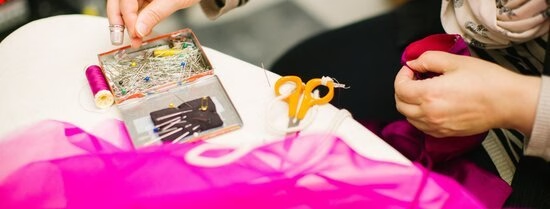Visible mending is the embodied and transformative practice of thinking-with-objects. Through embellishing damage, and incorporating repair as a part of the design of an object, visible mending can also act as a metaphor for a reparative ethos, a “mending mindset”, that valorises and normalises mending and repair over renovation or disposal. This blog is a reflection on the workshop “The Reparative University”, hosted by Sanne Koevoets and Angelica Vannucci during the DIT Day 2023. During this workshop, we gathered in mending circles to fix our favorite shirts, socks, and sweaters, while imagining futures for the university as a reparative space.
Written by Angelica Vannucci
We don’t know what the future of Erasmus University Rotterdam looks like, but we do know what we need to get there: a reparative ethos, or a ‘mending mindset’. Mending is a continuous process, defined by the damage found in an object and the tools one has available in the here-and-now. First, one must acknowledge, or even embrace, what doesn’t work. Then, one must “make do and mend” with what they have, accepting that the repair might be imperfect and celebrating that imperfection. Failure is the basis for improvement.
In the context of universities, this means: The only perfect design for a university is one that recognises that the university has flaws and must always be redesigned in response to internal and societal changes.
Developing a mending mindset
After a brief presentation by Sanne Koevoets, the ‘Reparative University’ workshop offered participants a chance to hone their practical mending skills by either darning or dry-felting their own clothes. During this time, we considered visible mending as an embodied, transdisciplinary practice that allows us to connect to ourselves, each other, and our community. We discussed the notion of a reparative ethos, through which everyone can value what already exists while building upon it.

Anyone can mend
Participants left the workshop with a (partly) mended item and materials to continue their mends at home. By refashioning their own clothes, they were able to emotionally engage in a process of “care and repair” and better conceive an understanding of mending as a material metaphor. To recognize value in what already exists, whether it be a sock or a university design, entails a commitment to its durability, which can only be achieved through repair, whether it be a darn or the adoption of transdisciplinary and transformative research and education. We agreed that anyone can mend, it’s simply a matter of “making do”.
An embodied practice
Derk Loorbach, the academic lead of the DIT platform, particularly enjoyed the workshop. By mending a small towel, he was able to recognize how important such a practice is:
“Not only to get out of one’s head and do something tangible, but also as a meaningful practice that makes you think about the use of materials, waste, durability, and how we can make things more valuable by adding our labor to it.”
Join our workshops and share your skills
At the Design Impact Transition (DIT) platform, we’re researching the potential of “Transformative Repair” in addressing societal challenges. Through a series of workshops such as this one, we seek to restore the cultural significance of mending to promote the transition to a sustainable culture of repair.
If you are interested in contributing to this project, you can do so by: participating in the mending workshops offered by DIT or our partners, sharing your skills and knowledge of mending techniques with the project lead, becoming a co-organizer of mending workshops, and/or getting in touch to organize a mending workshop for one of your courses, projects, or events. More information can be found here.
The DIT Platform would like to thank Sanne Koevoets and Angelica Vannucci for all of their vision and hard work to create and deliver this session. We would also like to thank the participants for the attendance.
- CV
About the author
Angelica Vannucci works for DIT as a research assistant and is conducting a digital ethnography on the subject of visible mending and societal transition. She is also a research master student at EUR, studying sociology of culture, media, and the arts.
- More information
About the Design Impact Transition (DIT) platform
The Design Impact Transition (DIT) platform creates infrastructures for transformative academic work at Erasmus University Rotterdam (EUR). Read more about our work here.

